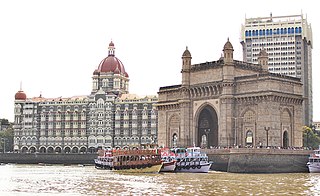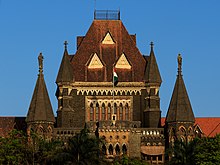
Chhatrapati Shivaji Terminus (officially Chhatrapati Shivaji Maharaj Terminus since 2017, formerly Victoria Terminus (VT), Bombay station code: CSMT (mainline)/ST (suburban)), is a historic railway terminus and UNESCO World Heritage Site in Mumbai, Maharashtra, India.

South Mumbai, colloquially SoBo from South Bombay in Indian English, administratively the Mumbai City District, is the city centre and the southernmost precinct of Greater Bombay. It extends from Colaba to Mahim and Sion neighbourhoods, and comprises the city's main business localities, making it the wealthiest urban precinct in India. Property prices in South Mumbai are by far the highest in India and among the highest in the world. In terms of Vidhansabha it is further divided in two parts - South and South Central. South has areas like Fort Colaba Girgaon to Worli Dadar and Prabhadevi, whereas South Central has Chembur, Wadala, Sion and Mahim.

Kala Ghoda is a crescent-shaped art district/neighborhood in Mumbai, India. It hosts several of the city's heritage buildings including museums, art galleries and educational institutions like the Chhatrapati Shivaji Maharaj Vastu Sangrahalaya, the Jehangir Art Gallery, the National Gallery of Modern Art, and The Arts Trust - Institute of Contemporary Indian Art.

A resident of Mumbai is called a Mumbaikar. People prefer to stay close to a railway station for easy access to the metropolis. Many city-dwellers lead a fast-paced life with very little time for other activities owing to a significant amount of time spent on daily commuting.

Watson's Hotel, now known as the Esplanade Mansion, located in the Kala Ghoda area of Mumbai (Bombay), is India's oldest surviving cast iron building. It is probably the oldest surviving multi-level fully cast-iron framed building in the world, being three years earlier than the Menier Chocolate Factory in Noisiel, France, which are both amongst the few ever built. Named after its original owner, John Watson, the cast and wrought iron structure of the building was prefabricated in England, and it was constructed between 1867 and 1869.

The Rajabai Tower is a clock tower in Mumbai India. It is in the confines of the Fort campus of the University of Mumbai. It stands at a height of 85 m. The tower is part of The Victorian and Art Deco Ensemble of Mumbai, which was added to the list of World Heritage Sites in 2018.

Chennai architecture is a confluence of many architectural styles. From ancient Tamil temples built by the Pallavas, to the Indo-Saracenic style of the colonial era, to 20th-century steel and chrome of skyscrapers. Chennai has a colonial core in the port area, surrounded by progressively newer areas as one travels away from the port, punctuated with old temples, churches and mosques.

Oval Maidan is a large Grade I recreational ground situated in South Mumbai, India. It is so named because of its oval shape and is situated just south of Churchgate. It is a popular recreation ground, with the most popular sports played there being cricket and football. The ground measures 22 acres (8.9 ha) in area. Political rallies and religious functions are banned in the maidan.

The Eros Cinema is an Art Deco style cinema theatre located in Cambata Building at Churchgate, Mumbai, India. It has a seating capacity of 1,204 people per show.

Dadabhai Naoroji Road (D.N.Road), a North–South commercial artery road, in the Fort business district in South Mumbai of Maharashtra, India, is the nerve centre of the city, starting from the Mahatma Phule Market ,linking Chhatrapati Shivaji Maharaj Terminus, leads to the Hutatma Chowk at the southern end of the road. This entire stretch of the road is studded with Neo–Classical and Gothic Revival buildings and parks built in the 19th century, intermingled with modern office buildings and commercial establishments.

The New India Assurance Building is an Art Deco office building made of reinforced concrete and designed by Master, Sathe and Bhuta, with artistic designer N. G. Pansare. It was constructed in 1937 in Mumbai, India for New India Assurance Co. Ltd., an Indian insurance company which was founded by Sir Dorabji Tata in 1919.
The architecture of Mumbai blends Gothic, Victorian, Art Deco, Indo-Saracenic & Contemporary architectural styles. Many buildings, structures and historical monuments remain from the colonial era. Mumbai, after Miami, has the second largest number of Art Deco buildings in the world.
Rahul Mehrotra is Founder Principal of architecture firm RMA Architects of Mumbai + Boston, and is Professor of Urban Design and Planning and Chair of the Department of Urban Planning and Design at the Harvard Graduate School of Design (GSD) in Cambridge, Massachusetts.

Maharashtra state in India is known for its Famous caves and cliffs. It is said that the varieties found in Maharashtra are wider than the caves and rock-cut architecture found in the rock cut areas of Egypt, Assyria, Persia and Greece. The Buddhist monks first started these caves in the 2nd century BC, in search of serene and peaceful environment for meditation, and they found these caves on the hillsides.

Many heritage structures are found in Mumbai, India.
Art Deco Mumbai (ADMT) is a public charitable trust that is actively involved in spreading awareness about Mumbai's Art Deco heritage since May 2016. It is a digital initiative that uses social media and a website to showcase the built heritage. The website is the only repository of information on Art Deco in Mumbai in the public domain.

The Art Deco in Mumbai, India style is a notable feature of the architecture of the city. It was used primarily for office buildings, residences and movie theaters, during a period when India was part of the British Empire. On 30 June 2018, an ensemble of such buildings were officially recognized as a World Heritage site by the UNESCO World Heritage committee held in Bahrain as the Victorian and Art Deco Ensemble of Mumbai.
Abha Narain Lambah is an Indian conservation architect whose eponymous architectural practice has restored several of India's UNESCO World Heritage Sites like the Ajanta Caves, Golconda Fort and Mahabodhi Temple, and Mumbai's Victorian buildings like the Crawford Market, Royal Opera House, Asiatic Society of Mumbai Town Hall and Knesset Eliyahoo Synagogue.

The Convocation Hall or Cowasji Jehangir Convocation Hall at the University of Mumbai is part of the Victorian buildings complex around the Oval Maidan in Mumbai that is a UNESCO World Heritage Site. It was built between 1869 and 1874, and designed by Sir George Gilbert Scott, who incidentally never visited Bombay and worked from London.

The University Library of the University of Mumbai is part of the Victorian buildings complex around the Oval Maidan in Mumbai that is a UNESCO World Heritage Site. It was built between 1869 and 1878 along with the Rajabai Clock Tower, and designed by Sir George Gilbert Scott, who incidentally never visited Bombay and worked from London.



























